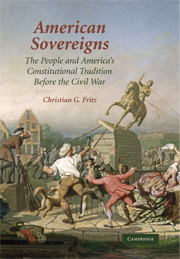Book contents
- Frontmatter
- Contents
- Acknowledgments
- 1 Prologue
- PART ONE THE PEOPLE'S SOVEREIGNTY IN THE STATES
- 2 Revolutionary Constitutionalism
- 3 Grassroots Self-Government: America's Early Determinist Movements
- 4 Revolutionary Tensions: “Friends of Government” Confront “The Regulators” in Massachusetts
- PART TWO THE SOVEREIGN BEHIND THE FEDERAL CONSTITUTION
- PART THREE THE STRUGGLE OVER A CONSTITUTIONAL MIDDLE GROUND
- Key to abbreviations
- Notes
- Selected Short Titles
- Credits
- Index
2 - Revolutionary Constitutionalism
Published online by Cambridge University Press: 31 January 2011
- Frontmatter
- Contents
- Acknowledgments
- 1 Prologue
- PART ONE THE PEOPLE'S SOVEREIGNTY IN THE STATES
- 2 Revolutionary Constitutionalism
- 3 Grassroots Self-Government: America's Early Determinist Movements
- 4 Revolutionary Tensions: “Friends of Government” Confront “The Regulators” in Massachusetts
- PART TWO THE SOVEREIGN BEHIND THE FEDERAL CONSTITUTION
- PART THREE THE STRUGGLE OVER A CONSTITUTIONAL MIDDLE GROUND
- Key to abbreviations
- Notes
- Selected Short Titles
- Credits
- Index
Summary
In the pouring rain on the morning of May 20, 1776, some four to five thousand American patriots – nearly 15 percent of the city's population – gathered in the State House Yard in Philadelphia. For three hours the crowd became “well-drenched” while hearing speeches and passing a number of resolutions directed at the colonial legislature due to meet in the State House later that day. They sent a clear message to the legislature.
The legislature's opposition to Independence threatened Pennsylvania's “Happy union with the other Colonies.” By pledging allegiance to America's “mortal Enemy, the King of Great-Britain,” the colonial government no longer represented the people. The crowd protested that because the legislature's authority came from the Crown, it lacked a crucial ingredient for constituting a legitimate government: “the Authority of the People.” Establishing “a new Constitution, originating and founded” on that authority required a body representing the people. This was not the colonial legislature.
Recent events prompted the crowd's challenge to Pennsylvania's government. When it met ten days earlier at the State House, the Continental Congress called for new governments to be established if current ones were not “sufficient to the exigencies of their affairs.” Moreover, on May 15 Congress added a preamble to the resolution calling for suppression of “every kind of authority” under the British monarch. Governments in America would now exist “under the authority of the people.”
- Type
- Chapter
- Information
- American SovereignsThe People and America's Constitutional Tradition Before the Civil War, pp. 11 - 46Publisher: Cambridge University PressPrint publication year: 2007

